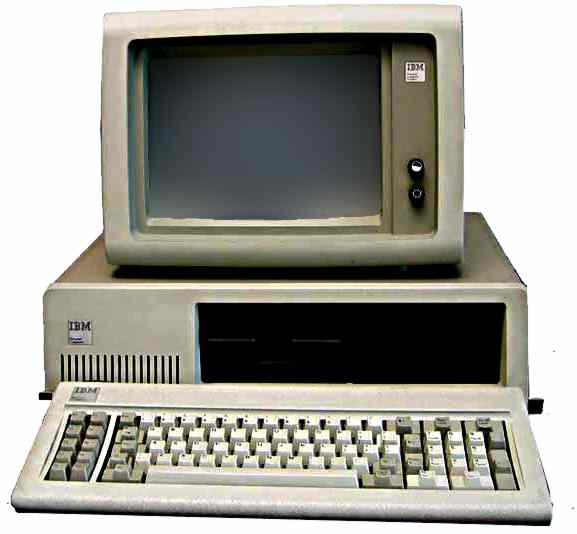| 40 Years Of The PC - We Recover An Original IBM PC |
| Written by Harry Fairhead | ||||
Page 1 of 3
IBM PC Model 5150
Big Blue's Approach to the World of the MicroThe IBM PC was introduced to the world on August 12 1981 but it almost didn’t happen. IBM's first thoughts about the entering the microprocessor market was to buy an existing firm - but only Atari was up for sale and it wasn't number one. Apple, which was number one, was definitely not up for sale so IBM thought hard about building its own machine. But the problem was that IBM was too big to compete in the fast moving world of the micro. Its standard development cycle was 4 years. The same timescale saw most microcomputer companies come from nothing to making a million. IBM chief Frank Cary asked "How do you make an elephant tap dance?" - good question! The answer was an independent business unit. To compete with the fast moving, garage-based entrepreneurs the IBM people would have to go native. IBM, Big Blue, had, and still has, a corporate culture that suppresses individual thought. There was, and is, a company song book, a uniform - the blue suit - and, most of all, job security. To build a PC you need none of these things.
Bill Lowe (1941 - 2013)
Bill Lowe, IBM's lab chief, suggested forming a group who could work outside IBM's normal framework. He scoured IBM for creative people to form the Project Chess committee in Boca Raton, Florida. The team leader was Jack Sams and he looked at the way that Apple had achieved success. He concluded that open architecture was the key. Let other people know the specification of the machine and let them develop add-ons. This was a very non-IBM way of thinking and IBM would spend many years after the original PC trying to get their technology back - but Sams was right because every time IBM tried to make a PC architecture proprietary the market rejected it. Jack Sams also came up with the notion that another company should produce the system software and he called up the head of a small firm - Bill Gates at Microsoft. Later in the project the team leader was changed to Don Estridge, a man who got along with Bill Gates very well indeed and ensured that PC-DOS would be a success. The hardware side of Project Chess was something of an anti-climax. On the other hand it would have been easy for the IBM team to produce something that was either so over-engineered that it was too expensive and difficult to use or something so underpowered as to be ridiculous. Remember IBM sold a lot of mainframes and had no wish to damage that particular source of cash. IBM chose the new Intel 8088 processor, the 8-bit variant of the full 16-bit 8086 processor. It seems strange now that they were worried that the 8086 might be too powerful! The architecture of the 8088 determined the architecture for the rest of the system. The address space was 1MByte but nobody at IBM could believe that any user would ever need that much in a personal computer and so they made the decision to divide the space up into 604KBytes of user space and 384KBytes for the system. Now, of course, we all know that this was a mistake. The system area was filled with 40KBytes of ROM and the video RAM. If you think that 40KBytes of ROM is a lot you are forgetting that back then it was the tradition to have Basic in ROM and this took 32KBytes leaving 8KBytes for the BIOS. The motherboard was designed to hold 64KBytes of RAM but 16KBytes was all that was expected to be fitted initially. Industry standard 16K DRAMs were used and one of the channels of a three-channel timer was used to generate the refresh signal. The other two channels were used to make the speaker beep and to build an audio-cassette interface - yes an audio cassette interface! In those days disk drives were rare and expensive things but most users still bought the disk version of the machine and the cassette interface was soon forgotten. They did build in an expansion bus though – the 8-bit version of the now almost obsolete ISA bus. Five expansion slot connectors were designed into the original motherboard and these soon proved inadequate. Although IBM was planning to use an open architecture policy for the PC, they never expected so many people to manufacture add-on cards. The early expansion cards only bothered to decode 8 address bits and so claimed large chunks of I/O space without really needing to! Another typically IBM design decision was not to build any sort of graphics into the machine. The machine was aimed at the small business and the home market. For business it needed a 25 line by 80 column text-only display and for the home a 320x200 colour display was appropriate. So the whole idea of video display adapters and jargon like MDA (Monochrome Display Adapter) and CGA (Colour Graphics Adapter) was born. Both display designs were poor. The MDA flickered so badly that it had to be used with a long persistence monitor to reduce the flickering. The trouble was when the screen scrolled it left an after-image. The CGA was intended to be used with a standard TV set and so it had a very low resolution 320x200 mode. To use it at either the 80x25 text and 640x200 in two colours mode you needed a monitor. Most users bought a monitor! The whole design was prototyped using a wire wrap board, a method of construction where thin wire is wrapped around metal pins by a small wire wrap gun. In theory the force of the wrapping welds the metal together but it doesn't always work that well. Two wire wraps were built and one was shipped off to Microsoft so that they could get on with developing the software. The trouble was that as the prototype heated up the wire wraps became loose and the board malfunctioned. Not the best way to try to develop software. When IBM finally introduced the PC the response wasn't what they expected. It wasn't really what anyone expected as the machine didn't look that good. IBM anticipated sales of 250,000 units over a five-year period. They sold that many in the first few months. There were constant shortages of supply and even a black market at one point. They had managed to produce something that everyone wanted. IBM's open architecture policy certainly contributed to the success of the machine. Software became available very rapidly and so did hardware add-ons. However IBM didn't quite get it right. Because they had used off-the-shelf parts other manufacturers were able to build copies, or clones, of the machine. In the early days people at IBM didn't seem at all sure about what it was that belong to them. They tried to make it sound as if parts of the machine were proprietary to IBM. They even emphasized the difference between PC-DOS and MS-DOS when they were, in fact, the same software produced by Microsoft. About the only part of the design that they could have claimed as their own was the BIOS - the code in the ROM that managed the hardware. This held up the clone manufacturers for some time but eventually they produced legal BIOS ROMs by getting programmers to write them from scratch given only a functional definition and proof that there had been no access to IBM's code. Once the cloners got started the price fell and the rest you know. |
||||
| Last Updated ( Monday, 16 August 2021 ) |


